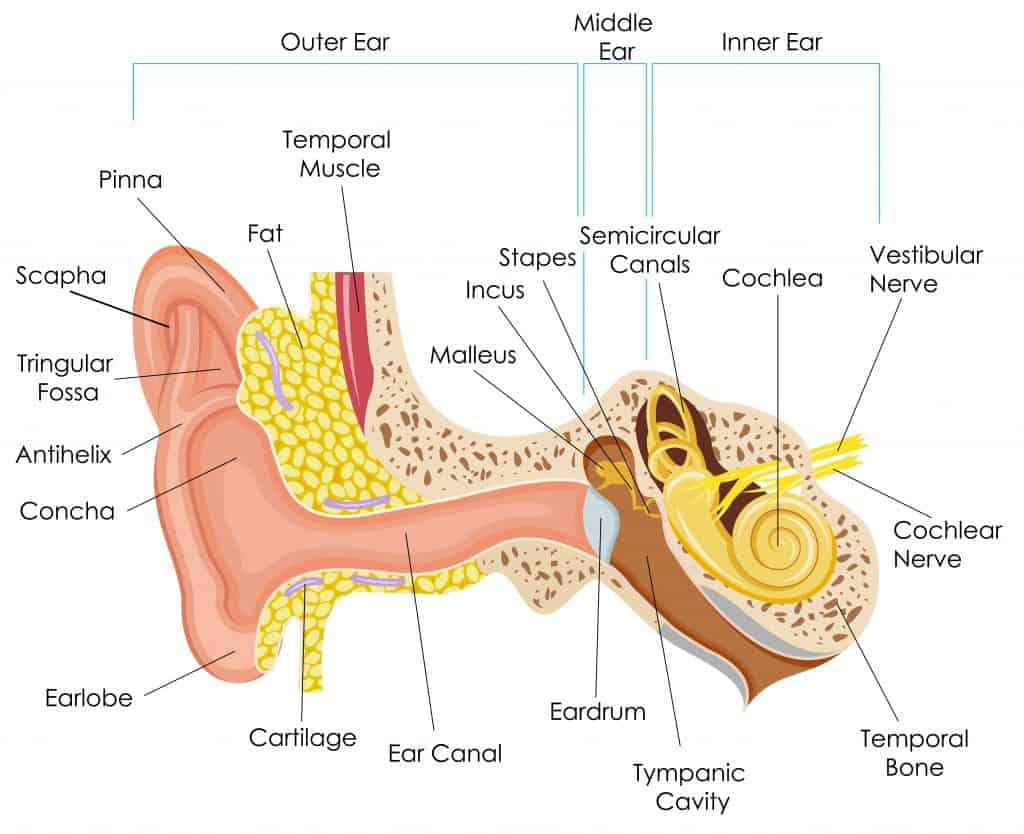The human ear is capable of hearing frequencies from 20 Hz up to 20 kHz, although this can vary from person to person, and also deteriorates with age. While younger adults are more able to hear frequencies approaching, and even surpassing 20 kHz, for those of a more advanced age, the upper limit of human hearing tends to fall well short of the 20 kHz upper limit.
Any frequencies above 20 kHz are referred to as ultrasonic. But to understand why ultrasonic waves are not audible to humans, we must first understand how sound is created and travels (or propagates), and how the human ear picks up and handles sound.
What is Sound
Sound is a mechanical waveform that requires a gas, liquid, or solid medium in order to propagate. This implies that unlike electromagnetic waves (such as light), sound cannot travel through the vacuum of space (or indeed any vacuum).
Sound propagates through the medium as a longitudinal wave, in which the compression and displacement of particles takes place in the same direction as the direction of travel of the wave. Sound can be quantified through several properties:
- Sound pressure – the amount of deviation caused by a sound wave to the normal, ambient atmospheric pressure of the medium, as it travels through the medium.
- Particle velocity – the velocity of the particles as the wave propagates through the medium.
- Sound intensity – sound pressure and particle velocity together give the sound intensity (or volume), typically expressed in dB.
- Density of the medium through which the wave will pass.
- The speed of sound – while generally though of as a constant, it is affected by the temperature and density of the medium. In air, it is typically 343 meters per second or 767 mph at 68 °F, and drops to 741 mph at 32 °F.
- Wavelength – the distance over which the pressure variation in a sound wave repeats (i.e. completes a full cycle, reaching a corresponding point of the same phase on the wave).
- Period – as a sound wave travels through a medium, a full wavelength requires a certain amount of time to pass a specific point in space. This is known as the period of the wave and is usually measured in seconds, milliseconds, or microseconds.
- Frequency – the number of wavelengths passing through a point in space within one second. Known as the frequency of the sound wave, it is measured in hertz or kilohertz.
Wavelength, period and frequency are interrelated. Think of them in terms of vehicles passing a check point. The speed of all vehicles is the same and constant (just as is the speed of sound). The wavelength is the length of each vehicle, from front to rear.
The amount of time taken from when the front of a vehicle crosses a given checkpoint, to when the rear clears that checkpoint, is the period and is obviously dependent on the length of the vehicle. The longer the vehicle, the greater the period (of time) required to clear the checkpoint.
The frequency, is how many vehicles of the same length, if they were placed in series one behind the other, could pass the checkpoint in one second. Again, since the speed of all vehicles is the same and constant, the longer or shorter the vehicle, the fewer or greater the number of vehicles that will pass the checkpoint, and hence, the lower or higher will be the frequency.
Most sounds, of course, are very complex waveforms composed of many frequencies. A single note played on a musical instrument (for example, the note A), comprises the fundamental frequency, and an infinite series of harmonic frequencies. It is these harmonic frequencies that give each instrument its distinctive sound. The same note has a different sound on a flute than on a violin or trumpet.
The Human Ear
The human ear works by converting sound energy to mechanical energy, and then to a nerve impulse that is sent to the brain. The human ear consists of three sections - the outer ear, the middle ear, and the inner ear.
Sound waves enter the outer ear via the pinna (or auricle), travel down the ear canal and eventually to the eardrum, making the eardrum vibrate. The eardrum (or tympanic membrane), is extremely sensitive to sound vibrations, being able to detect the faintest of sounds and the most complex of audio patterns.

The eardrum passes the sound vibrations on to the auditory ossicles of the middle ear. The auditory ossicles comprise three tiny bones, the malleus, incus, and stapes, connected in series, which work to amplify the sound vibrations before transferring them to the inner ear.
The malleus, the first of the three bones, receives any vibrations from the outer ear, and the stapes, the last bone in the chain, connects to the oval wall of the inner ear, where vibrations from the stapes create ripples in the fluids contained in the cochlea.
The inner ear is located between the middle ear and the internal acoustic meatus, and is made up of the bony labyrinth and membranous labyrinth. The bony labyrinth consists of a series of bony cavities comprising the cochlea, vestibule and three semi-circular canals, all filled with a fluid called perilymph.
The membranous labyrinth is filled with a fluid called endolymph, and is made up of the cochlear duct, semi-circular ducts, utricle and the saccule. The inner ear is innervated by the vestibulocochlear nerve, entering the inner ear via the internal acoustic meatus, and dividing into the cochlear nerve, responsible for hearing, and the vestibular nerve, responsible for balance.
Within the cochlea, hair cells (the sensory cells of the auditory system), respond to sounds based on their frequency. Any incoming sound waves create ripples in the fluid inside the cochlea, provoking a deflection of the hair cell stereocilia and creating electrical signals in the hair cells.
High-pitched sounds will stimulate the hair cells in the lower part of the cochlea, and low-pitched sounds in the upper part of the cochlea.
When hair cells detect a frequency to which they are tuned to respond, they generate nerve impulses that are transmitted along the auditory nerve. These nerve impulses follow a complicated pathway in the brainstem before reaching the auditory cortex, the hearing center of the brain, where they are converted into meaningful sound.
Why are Ultrasonic Waves Not Audible to Humans
The human ear is a very delicate, complicated and remarkable organ. When sound waves enter the ear, they are converted into vibrations that are passed along the ear canal, through the middle ear and on to the cochlea, where hair cells respond to frequencies they are tuned to detect, converting them to impulses that are sent to the brain.
These hair cells therefore, determine the human audible range. Any frequencies not picked up by the hair cells, are effectively filtered out. This is a natural, physical limit, and the range of human hearing is nominally accepted as being 20 Hz to 20 kHz, with any frequencies above 20 kHz being referred to as ultrasonic.
Of course, not everyone can hear at the extremes of the human auditory range. In general, young humans have better hearing than the elderly, being able to hear frequencies at, or even just beyond the boundaries of human hearing.
Side-note: It is for this reason that ultrasonic waves/frequencies can be used for pest control. For instance, gophers dislike noisy environments - the same could be said for other burrowing rodents.
However, age related hearing loss, called presbyacusis, is common among adults over the age of 65, leading to the gradual decline in hearing in both ears. Also, excessively loud noise or continual loud noise (above 85 dB) over an extended period, can damage the cochlear hair cells, leading to impaired hearing.
These are just a couple of reasons why many people have a less than a perfect hearing range.

